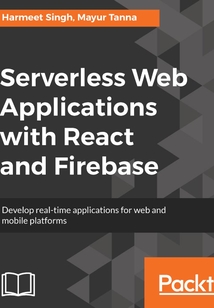舉報 

會員
Serverless Web Applications with React and Firebase
ThisbookisforJavaScriptdeveloperswhohavesomepreviousknowledgeofReactandwanttodevelopserverless,full-stackapplicationsbutwithoutthehassleofsettingupacomplexinfrastructure.
最新章節
- Leave a review - let other readers know what you think
- Other Books You May Enjoy
- Summary
- Redux Architecture benefits
- Benefit of higher-order components
- Use of PropType in React component
品牌:中圖公司
上架時間:2021-08-27 18:11:43
出版社:Packt Publishing
本書數字版權由中圖公司提供,并由其授權上海閱文信息技術有限公司制作發行
- Leave a review - let other readers know what you think 更新時間:2021-08-27 19:11:41
- Other Books You May Enjoy
- Summary
- Redux Architecture benefits
- Benefit of higher-order components
- Use of PropType in React component
- Semantics / structured syntax
- JSX components
- React Routing
- Immutable React State
- Difference between Redux and Flux
- Use of Redux
- Best practices with React and Redux
- Connect your app to multiple database instances
- Improve performance by metric
- Monitor Realtime Database
- Optimize database performance
- Enabling offline capabilities in JavaScript
- Managing the user session
- Custom claims
- Date object
- Avoid arrays
- Flattern data structure
- Avoid nesting data
- Writing the data
- Best practices with Firebase
- Best Practices
- Summary
- Deploying your site
- Firebase hosting
- Google App Engine
- Deleting files
- Downloading files
- Managing uploads and error handling
- Adding file metadata
- Upload Files
- Setting up the Cloud Storage
- How does it work?
- Key features of Cloud Storage for Firebase
- Access control
- APIs and tools
- Life Cycle Management
- Standard storage
- Coldline storage
- Nearline storage
- Regional storage
- Multi regional storage
- Storage classes
- Object immutability
- Resources
- Objects
- Buckets
- Key concepts
- Key features of Google Cloud Storage
- Google Cloud Storage
- Firebase Cloud Storage
- Summary
- Function termination
- Cloud Firestore Triggers
- HTTP Triggers
- Cloud Storage Triggers
- Authentication triggers
- Realtime Database Triggers
- Triggering Functions
- Deployment and execution of Cloud Function
- Initializing the Firebase Cloud project
- Firebase CLI
- Setup of Firebase SDK for Cloud Functions
- Life cycle of a function
- Private and secure
- No server to maintain
- Seamless integration with other Firebase Products and third-party APIs
- Key features of Cloud Functions
- Cloud Functions
- Server setup to send the notifications
- Client app setup to receive notifications
- Configuring the browser to receive messages
- Installing Firebase and Firebase CLI
- Setup of Firebase for Javascript web app
- FCM messages
- Versatile message targeting
- Sending upstream messages
- Sending downstream messages
- Key features of FCM
- Firebase Cloud Messaging (FCM)
- Using Firebase Cloud Messaging and Cloud Functions with React
- Summary
- Restoring from backups
- Setup
- Backups
- Data indexing
- Query-based rules
- Rule definition and structure
- Data validation
- Authorization
- Authentication
- Realtime Database Rules Overview
- How secure is your Firebase?
- Security risks and prevention
- Firebase Security and Rules
- Summary
- How data is structured in a JSON tree
- Verifying custom claim with Admin SDK sending the app
- Adding custom claim with Admin SDK
- Custom claims for admin access and security rules
- Creating and verifying custom token
- Initializing the Admin SDK
- Using the Firebase Admin Auth API with React
- Firebase Admin Integration
- Installation
- Firebase CLI
- Setting up Firebase Admin SDK
- User Profile and Access Management
- Summary
- Seat booking with Redux
- Advanced topics in Redux
- Data flow
- Store
- Reducers
- Action creators
- Actions
- Basics of Redux
- Presentational and Container components
- What is Redux?
- Integrating Firebase Realtime Database
- React setup
- Connecting React to Redux and Firebase
- Summary
- Supported types of Auth state persistence
- Authentication with email and password
- Managing the Login across Refresh
- Handling account exists errors
- Authentication with Google
- Authentication with Facebook
- Creating a login form with React for authentication
- Authentication with Facebook
- Firebase configuration for authentication
- React and Firebase setup with Node.Js
- Authentication with Firebase
- Summary
- The Ref attribute
- Props and state
- Firebase with React
- Add Ticket Form with React-Bootstrap
- Using React-Bootstrap
- React Form with JSX
- How to make your code neat and clean
- Advantages of using JSX in React
- What is JSX in React?
- React components
- Using React
- Installing React
- Setting up the environment
- Integrate React App with Firebase
- Summary
- child_moved
- child_removed
- child_changed
- child_added
- value
- Firebase events
- Getting started with Firebase
- AdWords
- AdMob
- App indexing
- Invites
- Remote config
- Dynamic Links
- Cloud Messaging
- Google Analytics
- Performance Monitoring
- Test lab for Android
- Hosting
- Cloud Storage
- How does it work?
- Cloud Functions
- FirebaseUI authentication for web
- Authentication
- Crash reporting
- Security
- Scalability
- Reliability and performance
- Querying
- Real-time and offline support
- Data model
- Difference between Realtime Database and Cloud Firestore
- Security rules
- Cloud Firestore
- Usage
- Backups
- Database rules
- Realtime Database
- Firebase
- The componentDidCatch() method
- The componentWillUnmount() method
- The componentDidUpdate() method
- The componentWillUpdate() method
- The shouldComponentUpdate() method
- The componentWillReceiveProps() method
- The componentDidMount() method
- The componentWillMount() method
- The render() method
- The constructor() method
- Methods info
- Component lifecycle
- React
- Getting Started with Firebase and React
- Reviews
- Get in touch
- Conventions used
- Download the example code files
- To get the most out of this book
- What this book covers
- Who this book is for
- Preface
- Packt is searching for authors like you
- About the reviewer
- About the authors
- Contributors
- PacktPub.com
- Why subscribe?
- Packt Upsell
- Serverless Web Applications with React and Firebase
- Copyright and Credits
- Title Page
- 封面
- 封面
- Title Page
- Copyright and Credits
- Serverless Web Applications with React and Firebase
- Packt Upsell
- Why subscribe?
- PacktPub.com
- Contributors
- About the authors
- About the reviewer
- Packt is searching for authors like you
- Preface
- Who this book is for
- What this book covers
- To get the most out of this book
- Download the example code files
- Conventions used
- Get in touch
- Reviews
- Getting Started with Firebase and React
- React
- Component lifecycle
- Methods info
- The constructor() method
- The render() method
- The componentWillMount() method
- The componentDidMount() method
- The componentWillReceiveProps() method
- The shouldComponentUpdate() method
- The componentWillUpdate() method
- The componentDidUpdate() method
- The componentWillUnmount() method
- The componentDidCatch() method
- Firebase
- Realtime Database
- Database rules
- Backups
- Usage
- Cloud Firestore
- Security rules
- Difference between Realtime Database and Cloud Firestore
- Data model
- Real-time and offline support
- Querying
- Reliability and performance
- Scalability
- Security
- Crash reporting
- Authentication
- FirebaseUI authentication for web
- Cloud Functions
- How does it work?
- Cloud Storage
- Hosting
- Test lab for Android
- Performance Monitoring
- Google Analytics
- Cloud Messaging
- Dynamic Links
- Remote config
- Invites
- App indexing
- AdMob
- AdWords
- Getting started with Firebase
- Firebase events
- value
- child_added
- child_changed
- child_removed
- child_moved
- Summary
- Integrate React App with Firebase
- Setting up the environment
- Installing React
- Using React
- React components
- What is JSX in React?
- Advantages of using JSX in React
- How to make your code neat and clean
- React Form with JSX
- Using React-Bootstrap
- Add Ticket Form with React-Bootstrap
- Firebase with React
- Props and state
- The Ref attribute
- Summary
- Authentication with Firebase
- React and Firebase setup with Node.Js
- Firebase configuration for authentication
- Authentication with Facebook
- Creating a login form with React for authentication
- Authentication with Facebook
- Authentication with Google
- Handling account exists errors
- Managing the Login across Refresh
- Authentication with email and password
- Supported types of Auth state persistence
- Summary
- Connecting React to Redux and Firebase
- React setup
- Integrating Firebase Realtime Database
- What is Redux?
- Presentational and Container components
- Basics of Redux
- Actions
- Action creators
- Reducers
- Store
- Data flow
- Advanced topics in Redux
- Seat booking with Redux
- Summary
- User Profile and Access Management
- Setting up Firebase Admin SDK
- Firebase CLI
- Installation
- Firebase Admin Integration
- Using the Firebase Admin Auth API with React
- Initializing the Admin SDK
- Creating and verifying custom token
- Custom claims for admin access and security rules
- Adding custom claim with Admin SDK
- Verifying custom claim with Admin SDK sending the app
- How data is structured in a JSON tree
- Summary
- Firebase Security and Rules
- Security risks and prevention
- How secure is your Firebase?
- Realtime Database Rules Overview
- Authentication
- Authorization
- Data validation
- Rule definition and structure
- Query-based rules
- Data indexing
- Backups
- Setup
- Restoring from backups
- Summary
- Using Firebase Cloud Messaging and Cloud Functions with React
- Firebase Cloud Messaging (FCM)
- Key features of FCM
- Sending downstream messages
- Sending upstream messages
- Versatile message targeting
- FCM messages
- Setup of Firebase for Javascript web app
- Installing Firebase and Firebase CLI
- Configuring the browser to receive messages
- Client app setup to receive notifications
- Server setup to send the notifications
- Cloud Functions
- Key features of Cloud Functions
- Seamless integration with other Firebase Products and third-party APIs
- No server to maintain
- Private and secure
- Life cycle of a function
- Setup of Firebase SDK for Cloud Functions
- Firebase CLI
- Initializing the Firebase Cloud project
- Deployment and execution of Cloud Function
- Triggering Functions
- Realtime Database Triggers
- Authentication triggers
- Cloud Storage Triggers
- HTTP Triggers
- Cloud Firestore Triggers
- Function termination
- Summary
- Firebase Cloud Storage
- Google Cloud Storage
- Key features of Google Cloud Storage
- Key concepts
- Buckets
- Objects
- Resources
- Object immutability
- Storage classes
- Multi regional storage
- Regional storage
- Nearline storage
- Coldline storage
- Standard storage
- Life Cycle Management
- APIs and tools
- Access control
- Key features of Cloud Storage for Firebase
- How does it work?
- Setting up the Cloud Storage
- Upload Files
- Adding file metadata
- Managing uploads and error handling
- Downloading files
- Deleting files
- Google App Engine
- Firebase hosting
- Deploying your site
- Summary
- Best Practices
- Best practices with Firebase
- Writing the data
- Avoid nesting data
- Flattern data structure
- Avoid arrays
- Date object
- Custom claims
- Managing the user session
- Enabling offline capabilities in JavaScript
- Optimize database performance
- Monitor Realtime Database
- Improve performance by metric
- Connect your app to multiple database instances
- Best practices with React and Redux
- Use of Redux
- Difference between Redux and Flux
- Immutable React State
- React Routing
- JSX components
- Semantics / structured syntax
- Use of PropType in React component
- Benefit of higher-order components
- Redux Architecture benefits
- Summary
- Other Books You May Enjoy
- Leave a review - let other readers know what you think 更新時間:2021-08-27 19:11:41


